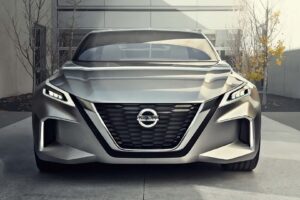Nissan Is Moving Away From The V-Motion Grille

Every car company has its own unique design language. For Nissan, the V-Motion grille has been a fixture in the US for more than a decade. The first iteration dates back to the original Juke from 2010, which had a tiny little V-Motion grille. In 2015, that design evolved into the more prominent version 2.0 that debuted on the Vmotion 2.0 concept (pictured here), and later in production form on the Maxima.
But as Nissan transitions to an electrified future – a future mostly devoid of grilles – the V-Motion motif probably won’t be part of that company’s plan moving forward. In an interview with Nissan’s Vice President for Global Design, Alfonso Albaisa, he noted that the design team isn’t focused on V-Motion.
“There’s a little bit left, but no, we’re not using these motifs so literally,” said Albaisa. “I think if we have one success is that nobody asks for [V-Motion] anymore inside the company. Or if they do ask, the other executives don’t follow. So one person can say, ‘What about V-Motion?’ And if the room is silent, that means it’s a minority voice and you keep going.”
Some of Nissan’s gas cars do still use the V-Motion design pretty prominently, but as we’ve seen on recently updated models like the Versa and Rogue, the former silver “V” accent is all but gone. The newer widened V shape on the front fascia of those models is similar to what debuted on the Ariya.
And as a whole, Nissan’s designs are moving in a new direction. Electrification is pushing Albaisa and his team to make these vehicles more efficient, but he still believes that style is hugely important to any vehicle design.
“We used to be able to put the nose wherever we want. All of the cars you see today, the nose is moving up a bit because we’re taking air under the nose,” Albaisa says. “I think that those first EVs have a tendency to be a bit jellybean-ish… and already people are pushing back.”
“Because we have like 13 or 14 [EVs] that we’re making, some are a bit smoother – they’re also cool – but you see the friction between the language. I don’t think people are patient, they want something new.”
Source: Read Full Article